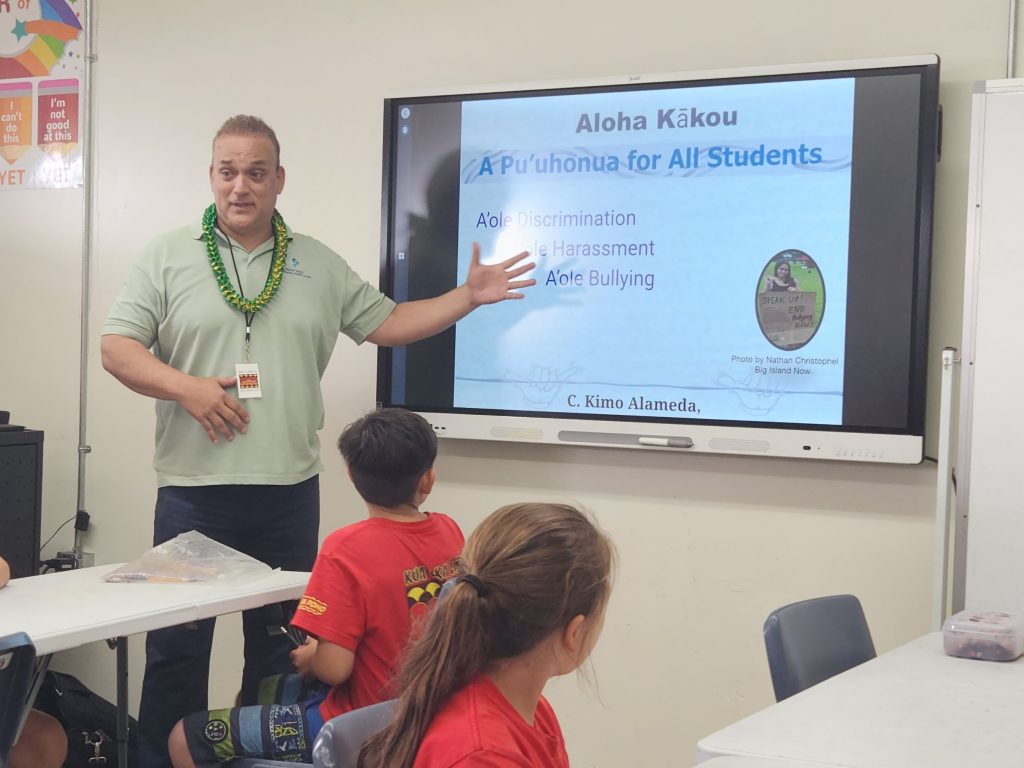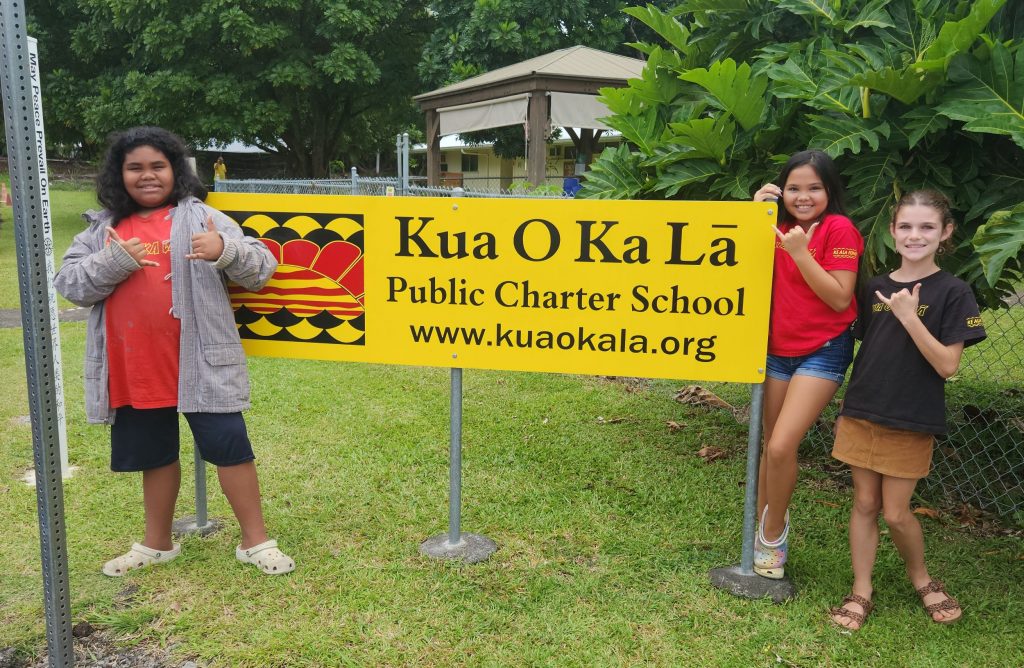Throwing a ‘SHAKA’: Alameda encourages students to ‘Save Hawai‘i and keep aloha’
Dr. Kimo Alameda went around the room at Kua O Ka Lā New Century Public Charter School in Hilo asking the fifth- and sixth-graders their names, and in one or two words what aloha means to them.

One by one, each of the more than 20 students — and two kumu (teachers) — introduced themselves and answered the question.
For some, it was hard to narrow it down, but all responses fit the word that has so many meanings and a deep cultural significance to Hawai‘i.
“Family, community, love, hello, goodbye, ‘ohana, respect. That’s great,” Alameda told the group. “It means everything what you just said.”
But the opposite of aloha — discrimination, bullying, harassment and hatred — is something Alameda thinks is happening more often than people might realize, including in Big Island schools.
“That’s why we say ‘a‘ole,” the Hawaiian word for no, he said. “We don’t want harassment. We don’t want bullying. And, we certainly don’t want discrimination.”
Alameda, the lead for the Hawai‘i Island Fentanyl Task Force, was invited to the Hilo charter school on May 22 to speak about the importance of showing aloha and accepting diversity. It was the fourth such presentation he gave before the end of the 2022-23 school year.
He also spoke at Pa‘auilo Elementary and Intermediate School in March and with two groups of students in April at West Hawai‘i Explorations Academy.
Addressing the fentanyl epidemic is important to Alameda, but equally as important is combating hate, disrespect, discrimination and cultural misunderstandings within the community.
Alameda is a former school counselor and special education teacher who has a Ph.D. in psychological, educational and cultural studies from the University of Nebraska. He previously provided “aloha training” for Big Island police and fire department personnel and cultural diversity training for Transportation Security Administration employees and the hotel industry.
He was called back to the cause after reading about a rash of bullying and violence at another Hilo school earlier this year that led to a community rally in response. Being in schools to give his fentanyl presentation, Alameda also had heard from administrators about bullying and other issues happening in their hallways.
His nearly hour-long interactive presentation included:
- Candid discussions about discrimination and bullying.
- How biases can lead to “isms” such as ageism, racism, sexism and others.
- His own personal experiences as a Portuguese-Hawaiian while living as one of the few minorities in a Nebraska town.
- How the way people speak makes a difference.
- How when people change the way they look at others, the way they look at people changes.
It focused on three truths: We are like everybody else. We are like some other people. And, we are like nobody else.
“We’re all a little bit different, but we all have some similarities,” Alameda told the students after having them stand for various reasons, including: Do you have hopes and dreams? Do you get angry or feel hurt?
When he was finished, everyone was standing.
“We all have dreams. We all have goals. We all have things that we like,” he said. “We all have similar interests.”
Differences also should be celebrated and seen as a way to connect with others.
But when differences become targets for those who are jealous or want to send negativity or hate, that’s when bullying, discrimination and disrespect begin to surface.
When people make negative judgements about others because of their age, ethnicity, gender, religion, nationality, socio-economic status, sexual orientation or how they speak, that’s not aloha, Alameda told the students.
“So somebody who has no more aloha in their heart, these [differences] become targets,” he said. “So we want to really stress that you guys gotta show love for these different groups.”
Aloha means to accept all those differences — aloha is acceptance.
Alameda said if someone is being bullied, do not encourage it or join in. Instead, help the person being bullied get away, report it to a teacher or adult and comfort the person who was mistreated.
“I always think that everybody’s perfect, just like the sky,” he said, explaining there is only one sky. “You guys are all perfect because you’re the only one. … Now sometimes you might have cloudy days, hot days, rainy days, but that doesn’t mean you’re not perfect.”
Alameda, who was wearing a lei given to him by the students, encouraged them to use their words to uplift instead of put down — the words that come out of people’s mouths began in their hearts, and he knows all of the students have good hearts. They should practice aloha always; after all, it is the law in Hawai‘i.
“Our government was so impressed with the word aloha that many years ago they put it into law,” he said. “This is so awesome to me.”
Chapter 5 of Hawai‘i code defines aloha spirit as the coordination of mind and heart within each person. Aloha is more than a word of greeting or farewell or a salutation. Aloha means mutual regard and affection and extends warmth in caring with no obligation in return. Aloha is the essence of relationships in which each person is important to every other person for collective existence. Aloha means to hear what is not said, to see what cannot be seen and to know the unknowable.
“It’s pretty much what you all shared today, which is unbelievable,” Alameda said. “If you can keep the aloha going, wow. When you get to my age, you’re gonna be very successful because nobody can be good at anything if they’re not a good person first.”
The best place to start is with yourself and accepting the differences of others, he said before wrapping up his presentation with a “SHAKA.”
“Save Hawai‘i and keep aloha,” Alameda said. “That’s why I always do the double shaka because we gotta double-down on this because it’s tough times right now.”
Kua O Ka Lā Principal Vanessa Dilcher said she hopes the students really understand the importance of showing and living with aloha and how that can impact their daily lives and the lives of those around them.

Sixth-grader Jaisaea Miranda said the presentation taught her to think before acting. She said she is going to put the lessons she learned into practice by not bullying anybody and making sure to be nice to people.
“I loved Dr. Kimo’s presentation,” said sixth-grader Kawika Carden Jr., who especially took to heart the lessons of not bullying and trying not to judge others by what they do.
Fifth-grader Olive See said: “I think that I’ll be more accepting to others and their cultures and what they do with their lives.”
All three students said they have experienced some form of bullying and the presentation reinforced ways to get past it.
“There is so much mixed and harmful messaging students are navigating that they need help,” said Joe Greenberg, principal of West Hawai‘i Explorations Academy. “Dr. Kimo shares a positive message of hope and honor that is empowering [them] to be the best version of themselves and to look out for one another because who we are to ourselves is often the result of who we are to each other.”
Greenberg said he thinks the students in grades 6-12 at the academy who experienced the presentation have been able over time to internalize the message: “I do see students striving to learn how to live with aloha in ways that feel real and just.”
Pa‘auilo Elementary and Intermediate School Counselor Tiana Reynolds said she has notices that the grade 6 through 9 students who heard the presentation have “shifted their mindsets and overall seem to be more socially aware. I noticed that students have made a positive change in their choice of words and ultimately have chosen to show their aloha to others with words, positive actions and mainly coming together as one school community.”


She said the value of aloha is vital for all students’ education because it teaches them the foundational skills they need throughout life, including being proud of who they are and where they come from, standing up for what is right, learning and growing with a positive and open mindset, how to effectively work with others, helping others, taking care of the land and the people living on it and others.
Alameda said his presentation can provide a base for which teachers can go back and use as a springboard for further discussions about diversity and acceptance. He also hopes other schools around the island will invite him to continue spreading the message of aloha next school year.
“It is a process, and our children evolve into the best versions of themselves through many different lived and shared experiences,” Greenberg said. “I believe that Dr. Kimo and the love and energy he shares is infectious and impactful. I think dedicating the time he does to working with young people in our community is affecting change.”
Sponsored Content
Comments
















